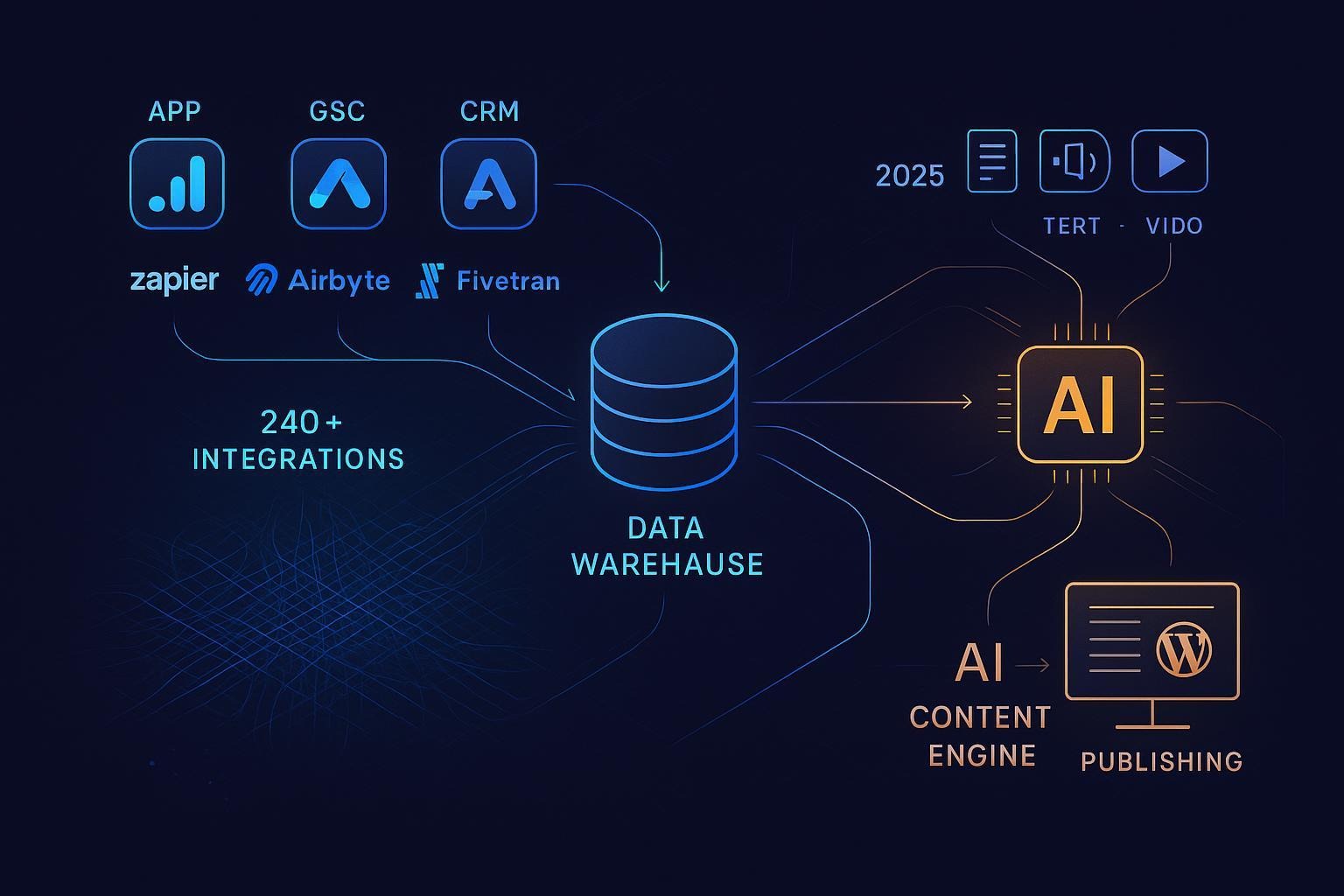A content marketing workflow covering 2025: in the place where automation and strategy converge.
In the current information environment, speed and scale are not luxurious, but rather the norm. The winning companies are the ones that have made their engine engine their workflow a well-oiled machine, which is capable of projecting the appropriate message at the appropriate time, to the appropriate person, on the appropriate channel. This engine is automation, AI support, and deep data integration-powered.
We should turn to what the modern working process is like, why it is necessary, how to construct it and what progressive techniques are becoming more and more prominent as we approach the year 2025.
Why Workflow Automation Isn’t Just a Nice-to-Have Anymore
With a sudden explosion of content and the escalating expectations of the audience, manual operations are no longer able to keep pace. Some pieces of data that are noteworthy:
More than 68% of organizations say they’ve adopted generative AI tools in their stacks. indicate that they have implemented generative AI in their stacks.It is found that automation is saving marketers 5+ hours a week on average- and in some cases, even more.
The workflow and content-automation platforms are to reach the unprecedented level of the market of approximately ~32.5 billion in 2035 compared to the present level of around 11.8 billion in 2024. In brief: automation is not an option in the future but a strategy that has already become a competitive tool. In its absence, content teams will end up being flooded, inconsistent, and less responsive and more reactive.
The 2025 Content Workflow: From Idea to Impact:
The following is a new diagram of how a content workflow works currently, generalized into main phases and imbued with automation.

1. Strategy & Insight
The premise: you do not start with writing something, but with data. The automation that is being implemented at this stage involves:
- AI-based topic and trend discovery: search behaviour scanning, competitor indicators and gap detection.
- Automatic key word and intent scoring: performing a pre-ranked collection of content prospects.
- Workflow rules: specify that when a subject is selected, it initiates a short process, an author is assigned and a schedule is established.
Why it is important: according to surveys, 65.6% of marketing teams already have AI analysing unstructured data (§ emails, transcripts, social) to consume their content machine.
2. Creation & Optimization
When the idea is locked, creation starts- but with help of automation:
- Outlines or draft-versions (to be edited by human writers) generated by AI.
- Live preview, tone, brand-voice, in-built tools to check SEO on the editor.
- Recommendation systems in visual assets or automatic generation of images/graphics.
- Predictive tools which approximates content performance - provides early indications of likely draft success.
Results: In one study that found personalized content instigated by AI, the engagement rate increased 202%.
3. Review & Approval
In this matter, the more volume the more chaos. Automated workflows help:
- It is automatically constituted to go to the appropriate reviewer according to the type of content or topic.
- Alerts, urgency controlled in the workflow.
- Bottlenecks are minimized by version-control and change tracking as well as parallel review.
- Half a year with project-management platforms goes unused, making sure that there are no hand-offs between teams.
It is a crucial stage: the quicker you pass, draft and publish, the more competitive you become.
4. Distribution & Repurposing
Publishing is not simply hitting “upload” anymore—it’s about orchestrating across channels. Automation you want:
- Cross-platform formatting: one piece of content auto-repurposes into social posts, excerpts, newsletters.
- Scheduled publishing: tools optimise for best timing based on audience behaviour.
- Auto-syndication or partner-distribution rules: reach beyond your owned channels.
- Content lifecycle rules: e.g., after initial publishing, repurpose after X days as a recap/infographic/email.
Automation at scale drives consistency and saves vast amounts of time.
5. Performance Tracking & Feedback
The final and most strategic stage: using data to loop back and improve. Automation includes:
- Dashboards aggregating performance data (engagements, conversions, SEO impact) in real time.
- Automated A/B testing workflows: trigger variants, track performance, push winners live.
- Attribution engines that follow content across touch-points.
- Feedback triggers: under-performing content automatically flagged for update or repurpose.
According to a content stack survey, 68.7% of marketers are already using AI workflows for summarising, personalising or automating message/content flows.

Assembling Your Workflow: The 5-Step Guide to Building Your Own
1. Lay the Strategy Foundation
- Set clear objectives whether it’s brand awareness, lead generation, or customer retention.
- Audit your existing funnel content and identify bottlenecks or performance gaps.
- Select tools that can consume and interpret data (e.g., search trends, social signals) to recommend high-performing content topics.
Tech Tip:
When building your strategy, ensure your MarTech stack includes:
- CMS (Content Management System)
- CRM (Customer Relationship Management)
- Marketing automation tools
- Content analytics platforms
AI Capability Checklist:
- Generative AI
- Predictive analytics
- Seamless integrations
According to recent surveys, 76.9% of companies use marketing automation platforms, and 68.6% have already adopted generative AI tools.
2. Eliminate Human Labor, Automate the Routine
- Outsource monotonous tasks like scheduling, formatting, and creating rough drafts to automation tools.
- Free your human teams to focus on strategy, brand voice, and high-stakes creative work.
Research shows that human–AI teams are approximately 60% more productive than teams without automation (source: arXiv).
3. Select and Integrate the Appropriate Stack
- Choose tools that integrate seamlessly within your workflow, your tablet-type, stack, or platform should fit your team’s technical and creative needs.
- Ensure interoperability between your AI tools, analytics, and marketing platforms for smooth data flow.
4. Multi-Channel Distribution Orchestration
- Build workflow rules: when content is published, it automatically converts into multiple assets e.g.,
- X social posts
- Y email snippets
- Z partner updates
- X social posts
- Use scheduling algorithms to optimize posting times based on audience activity for each channel.
- Create remix triggers:
- Blog post → Infographic → Short video
- Blog post → Infographic → Short video
This ensures maximum content reach with minimal manual effort.
5. Observe, Measure, and Continuously Optimize
- Set up dashboards to track key metrics like:
- Production time saved
- Content velocity
- ROI per content piece
- Production time saved
- Implement automation to flag underperforming content and trigger repurposing workflows.
High-Order Automation Future 2025 and Beyond.
1. Personalization at Scale
Although personalization is a buzzword, automation makes it possible. AI is able to process user actions and segmentations on-the-fly and modify the content delivery process. The studies give a hint that with this kind of engagement the engagement is increased several times.
2. Omnichannel Orchestration
It is no longer exclusive to the platforms that can produce smooth experiences. Automation coordinates web, email, mobile, social messaging on an automatic basis, whereby context and timing is maximized per channel.
3. Content Analytics: predictive
Top teams are also currently employing predictive analytics to predict what performance will seed rather than merely react to what content did. That is to say that times or issues, forms and media are to be prioritised in a proactive manner.
4. The Ecosystem Integration and Massive Connectors.
The current day automation is able to assist hundreds of data-connectors and workflows. As an example, a few of these platforms have incorporated 240 and above data-sourc es and AI connectors to drive content workflows.

Image Source: statics.mylandingpages.co
Top 10 Pitfalls and Ways to Avoid them
- Too many tools: Despite the number of tools, there are no guarantees of success. The point is not on features lists, but workflow design.
- Ignoring brand voice: Automation is being used to accelerate; however, your brand story should have human management.
- Lack of Data hygiene: garbage in, garbage out. Clean signals are relied on to achieve automation.
- Neglecting change management: New working processes imply new duties. Train your team.
- Excessive automation in workplaces: When introducing automation, go small and grow big.
Talent & Roles in This New Workflow
- Content Strategist: Establishes themes, aligns these to business needs, oversees the health of the workflow.
- SEO Specialist, Insights Specialist: Specializes in the data, keywords strategy, performance indicators, search intent.
- Content Creator/Writer: Has a concentration on the story, brand voice, high-value creative, machine-assisted.
- Content Operations / Workflow Manager: Coordinates tools, makes sure there is integration, oversees bottlenecks.
- Distribution & Community Manager: Manages multichannel delivery, community.
Conclusion:
The content marketing in 2025 will not imply the production of larger quantities of content. It is all about smarter content, content that is faster delivered, is delivered to the right person and its impact is measured in real time. The leaders and the laggards differ by automated workflows that are driven by artificial intelligence, abundant integration, and orchestration.
To remain relevant, or even better, be ahead of the market, you need to develop a content engine, not the responding type, but the predicting type. Automate your workflow, select the right tools, empower your staff and give the automation the remaining tasks.
.png)



.jpg)




